Ming Dynasty
Establishment
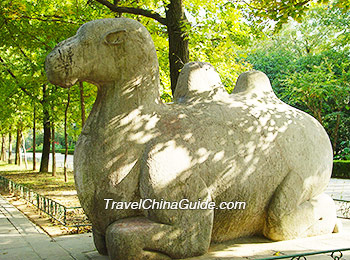 |
| Stone Camel on Sacred Way, Ming Xiaoling Mausoleum, Nanjing |
In the late period of the Yuan Dynasty (1271 - 1368), a peasant's uprising - Hongjinjun (army with red scarf in the head) uprising broke out against the Mongols. In 1352 when the rebel army captured Haozhou (currently Fengyang in Anhui Province), Zhu Yuanzhang, a local young man from a peasant family joined the army. After that, Zhu served with distinction in the battles. He was then chosen as general by a rebelling warlord named Guo Ziyi. After the death of the rebelling warlord, Zhu took control and continued forth to realize his plan to take control over all of China. In 1356, Zhu led his army into the city of Jiqing (currently Nanjing in Jiangsu Province), changed the city name into Yingtian and established his own military base there. Through several years' efforts, both the military and economical strength of Zhu's army quickly became stronger. From 1360 to 1367, his army managed to eliminate the remaining separatist military forces.
In 1368, Zhu Yuanzhang officially proclaimed himself emperor in Yingtian and founded the Ming Dynasty.
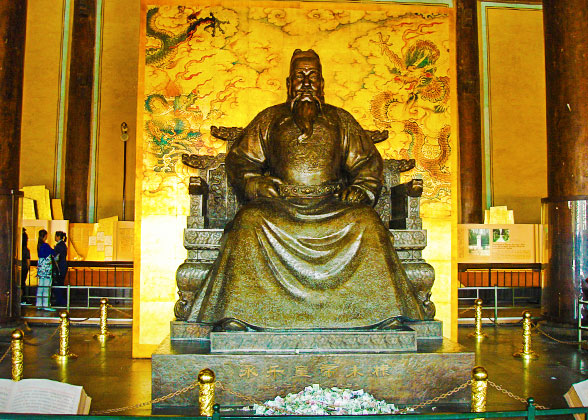 |
| Statue of Zhu Di, the third emperor of Ming Dynasty |
In the same year, the Ming army captured Dadu (currently Beijing), the capital city of Yuan, and rid China of most of the remaining Mongols, ultimately ending Yuan.
Early Reign
After the founding of the new dynasty, Zhu Yuanzhang implemented a series of policies to reduce the peasants' burden and to resume the production of the whole society. On the other hand, he focused much attention on the punishment and prevention of corruption among court officials. Additionally, he sent his sons to supervise the local administration so as to strengthen his hold on imperial power. After Zhu Yuanzhang died, his grandson Zhu Yunwen took over the throne. However, his reign only lasted for four years, ending in a coup launched by Zhu Di, the fourth son of Zhu Yuanzhang. Hence, Zhu Di was Emperor Chengzu, whose reign was considered as one of the most prosperous periods in this dynasty. During his reign, an unprecedented encyclopedia called Yongle Dadian was regarded as the biggest and earliest encyclopedia in the world. From 1405 to 1433, Emperor Chengzu sent a eunuch named Zhenghe to lead Ming's fleets across the Indian Ocean. They visited many countries in Southeast Asia, expanding the influence of the Ming Dynasty in the world. Meanwhile, Emperor Chengzu began to construct an imperial palace from 1406 and moved the capital city from Yingtian to Beijing in 1421.
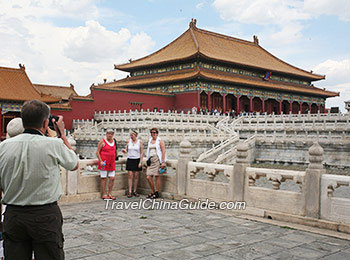 |
| Forbidden City, Beijing |
Decline and Fall
The turning point from prosperity to decline was the reign of Emperor Shenzong. In the early period, under the wise assistance of a skillful chancellor, Zhang Juzheng, Emperor Shenzong made much improvement in the national economy, agriculture, water conservancy and military affairs. However, after the death of Zhang Juzheng, the emperor began to neglect state affairs. In his late reign, the Ming army was defeated by the leader of the so-called 'Latter Jin' regime - Nurhachu in the Battle of Sarhu. Since then, the Ming court fell into a passive state in confrontation with the 'Latter Jin' set up by Nuzhen ethnic minority.
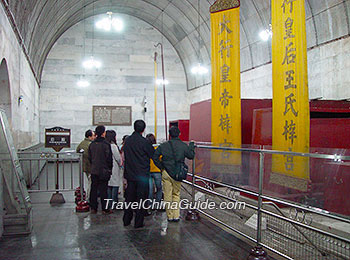 |
| Dingling, Beijing Ming Tombs |
The end of this dynasty started from the last emperor, Emperor Weizong's reign - the reign went by the name Chongzhen. The crisis was caused by the corruption of the court officials and the domination of the eunuchs. In that period, both the exploitation from the ruling class and natural disasters in successive years caused the people to live in extreme hardship. In 1628, dozens of rebel military forces launched battles in the northern area of Shaaxi Province. Among them, one of the leaders of the rebel army was named Li Zicheng, and he was deeply trusted and supported by most peasants. In 1644, Li Zicheng captured Xi'an and founded a new regime called Dashun. In the same year, Emperor Weizong hanged himself in Jingshan Hill of Beijing, signifying the end of this dynasty.
Economy
Economically, the Ming Dynasty was a period during which the feudal society began to show the declining trend while the capitalism started to originate. In agriculture, both the food output and the implements of production surpassed that of the Song and Yuan Dynasties. From the early period, the handicraft industry in the southern areas developed rapidly. Especially, the porcelain making industry reached an unprecedented level. Since the reign of Zhu Yuanzhang, it had been a major source of the state finance. The currently famous Jindezhen kiln was once the imperial kiln in that period.
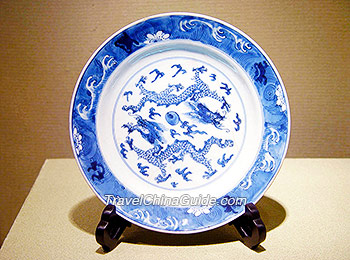 |
| Blue and White Porcelain, Ming Dynasty |
The development of the handicraft industry promoted market economy and urbanization. During the reign of Emperor Shizong and Emperor Shenzong, a great amount of commodities including silk, alcohol, porcelain, tobacco, crops, vegetable and fruits was sold in the market. Meanwhile, many foreign commodities such as clocks from Europe and tobacco from America were on sale in many cities of China. Also, a series of commercial metropolises including Beijing, Nanjing, Yangzhou, Suzhou, Guangzhou, Xi'an and Chengdu were successively formed. However, the later policy of restraining commerce and the stringent ban on shipping greatly hampered commercial development.
Culture and Science
The culture developed rapidly, especially in literature. Three of the four great classical masterpieces of Chinese literature - Journey to the West, Outlaws of the Marsh, and Romance of the Three Kingdoms were written in during this period. Besides, another two well-known novels - Peony Pavilion and The Plum in the Golden Vase were also excellent works in that period. Meanwhile, folk literature prospered, represented by a group of writers such as Tang Yin, Song Lian, Zhang Dai, Wu Weiye and Yuan Hongdao. In philosophy, Wang Yangming's new thoughts called 'philosophy of the mind' formed a new thinking wave which helped shape a new social trend.
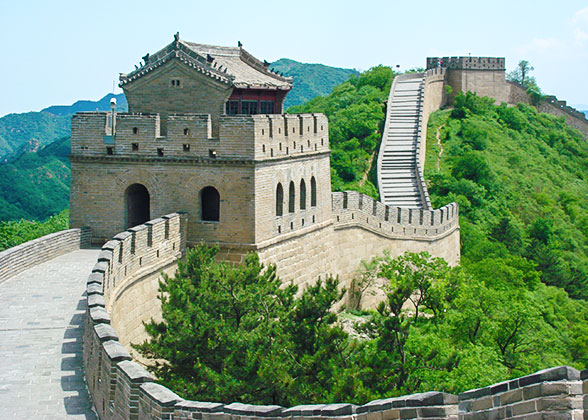 |
| Badaling Great Wall, Ming Dynasty |
Before the 16th century, the scientific development of the Ming Dynasty had been in the forefront of the world.Many scientific books appeared in the early and middle period, namely, medical book Compendium of Materia Medica by Li Shizhen, Song Yingxing's Heavenly Creations about handicraft industry, Xu Guangqi's Complete Treatise on Agriculture and Xu Xiake's Travels of Xu Xiake. All these have been the precious documents for today's study of the ancient technology. Additionally, the military technology was relatively advanced in that period. A kind of gun called 'huochong gun' and powerful artillery were invented in the late period. It is said that a man named Wan Hoo even tried to fly to the sky by sitting in a chair propelled by gunpowder sticks. Unfortunately, he failed and became the first sacrifice in human conquest of the sky.
In the end, the greatest achievements accomplished during this time were on architecture. The Forbidden City in Beijing was crafted this time. Porcelain making was also relevant during this time, which contributed to arts of present day.
Ming Dynasty Emperors
| Order | Name | Notes | Reign Time (years) |
|---|---|---|---|
| 1 | Ming Taizu / Emperor Hongwu (Zhu Yuanzhang) | Founder of the Ming Dynasty; once entered a monastery and later a leader of the peasant's uprising army. In 1368, he proclaimed himself emperor in Yingtian (today's Nanjing). | 1368 - 1398 |
| 2 | Ming Huizong (Zhu Yunwen) | Grandson of Zhu Yuanzhang; Originally, his father Zhu Biao was designated as the heir. He came to the throne because of Zhu Biao's early death. | 1399 - 1402 |
| 3 | Ming Chengzu (Zhu Di) | The fourth son of Zhu Yuanzhang; He usurped the throne by from the hands of Zhu Yunwen. His reign was said to be the most prosperous period of the Ming Dynasty. | 1403 - 1424 |
| 4 | Ming Renzong (Zhu Gaochi ) | The eldest son of Zhu Di; His reign was short because of his early death. But he was remembered as an innovative emperor. | 1425 |
| 5 | Ming Xuanzong (Zhu Zhanji) | Son of Emperor Renzong; ruled for ten years and died of illness | 1426 - 1435 |
| 6 | Ming Yingzong (Zhu Qizhen) | Son of Emperor Xuanzong; He ascended the throne at eight and was later imprisoned by Mongols due to the failure of Tumu Crisis. After being house arrested for seven years, his launched a coup and regained his second reign. | 1436 - 1449, 1457 - 1464 |
| 7 | Ming Daizong (Zhu Qiyu) | Younger brother of Yingzong; He was put on the throne after his brother was captured by Mongols. | 1450 - 1457 |
| 8 | Ming Xianzong (Zhu Jianshen) | Son of Emperor Yingzong; He ascended the throne at 17 and was once infatuated with a consort who was 19 years old than he was. | 1465 - 1487 |
| 9 | Ming Xiaozong (Zhu Youtang) | Son of Emperor Xianzong; He was the sole perpetually monogamous emperor in the whole of Chinese history. | 1488 - 1505 |
| 10 | Ming Wuzong (Zhu Houzhao) | The eldest son of Emperor Xiaozong; He was irresponsible and indulged himself in playing with women. | 1506 - 1521 |
| 11 | Ming Shizong (Zhu Houcong) | Cousin of Emperor Wuzong and nephew of Emperor Xiaozong; He was also infatuated with women as well as Taoist alchemical pursuits. | 1522 - 1566 |
| 12 | Ming Muzong (Zhu Zaihou) | Son of Emperor Shizong; He was considered as an open-minded emperor since he used to adopt a series of positive policies the reverse the declining situation. | 1567 - 1572 |
| 13 | Ming Shenzong (Zhu Yijun) | Son of Emperor Muzong; His reign was the longest one among the Ming emperors. He also received Matteo Ricci the first christian missionary. | 1573 - 1620 |
| 14 | Ming Guangzong (Zhu Changluo) | The eldest son of Shenzong; His reign was less than a half year due to his mysterious death which was probably caused by the so-called red pills. | 1620 |
| 15 | Ming Xizong (Zhu Youxiao) | The eldest son of Guangzong; He came to the throne at 15 and his reign was controlled by a treacherous court official named Wei Zhongxian. | 1621 - 1627 |
| 16 | Ming Weizong (Zhu Youjian) | Son of Guangzong and younger brother of Xizong; He reign was thought to hasten the end of the Ming Dynasty. In 1644, he committed suicide in Jingshan Park after Li Zicheng captured Beijing. | 1628 - 1644 |